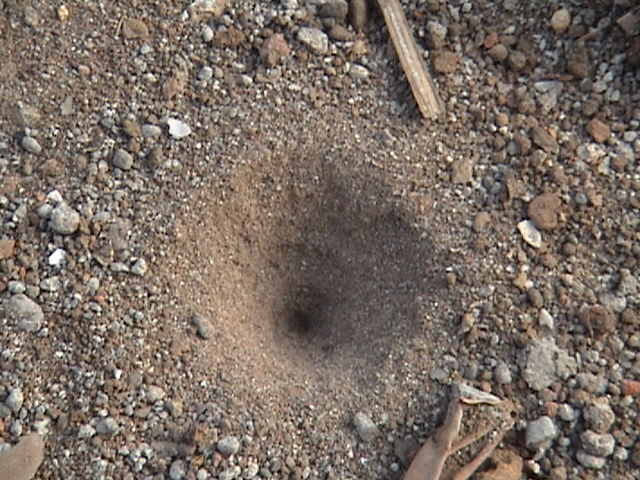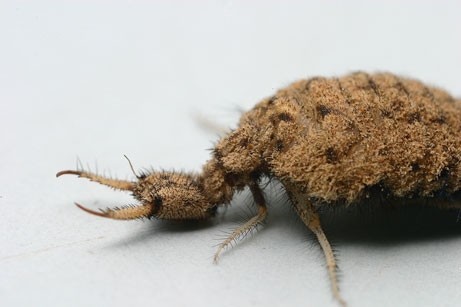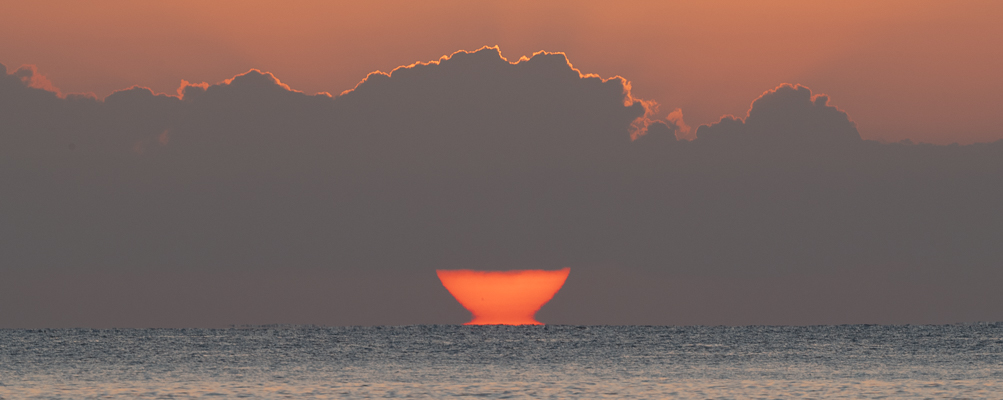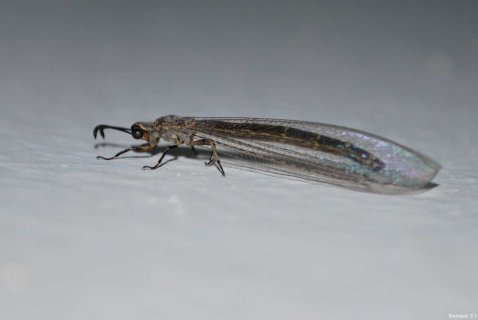Last week I wrote about a couple of recent entomological sightings, one from the order Hemiptera (true bugs) and one from the order Neuroptera (nerve-winged bugs, the lacewing family). I thought it was about time to post an observation featuring another neuropteran, this time an unidentified myrmeleontid (antlion) species. (Myrme-leon=ant lion, by the way.)
I saw the animal last September at the old house, but have been sitting on the observations since then, hoping against hope for a positive ID from the bugguide.net people. But it looks like the photo quality is too poor to enable identification to species, so there’s no point waiting any longer.
Most people are more familiar with the larval form, or at least the sign that the antlion larva is present: the sand trap.

But fewer are familiar with the larva itself, unless, like the curious kindergardener I was decades ago, they have spooned one up from below the trap (image from Wikipedia again):

Intimidating, isn’t it? Those huge jaws, that powerful humped back, those hairs sticking out everywhere. They’re also ferocious predators; any creature small enough to be trapped in the pit is probably also small enough to be overpowered by those jaws, and I witnessed many such beasts fall prey to the doodlebug in my youth. If the doodlebug were substantially larger, it might be dangerous to people, but even the “giant” forms are too small to inflict damage on even a small human finger.
The adult form is a bit less monstrous, but still rather scary to some people. I saw this one on the wall of our front porch at our old house; I’ve been holding back on this post until the bugguide.net people could ID it, but apparently antlion ID is not as easy as one might like. I’ve been waiting since last September, and since I finally got a neuropteran post last week, it would be a shame to hold out for specific identification:
According to my Florida’s Fabulous Insects, Florida is the “premier antlion state of the East,” with 22 species recorded. The one I found above appears quite similar to one that Deyrup describes in his book as “one of several Florida species whose larvae do not make pits.” I haven’t noticed many antlion pits on the old homestead, or at the new one, so perhaps my guy really is one of the nonbuilders. Oh, well.
The adults are nocturnal, and I’m not clear on what they eat. It’s possible that they don’t eat much of anything, since most species live for a very long time as larvae (up to 2-3 years) and as adults their only imperative is to pass on their genes. But I don’t know for sure…
One of the things that I’d love to explore, and I expect someone already has, is whether there is a single universal angle where the antlion pit is most effective, or whether it varies by substrate. Does fine sand differ from coarse sand in its ability to trap prey? Does it need to be steeper or shallower to be effective?
For those species that don’t build pits (I hadn’t realized there were any such until I started researching the family), where do the larvae live? How do they feed? Are they ambush predators, or sit-and-wait predators? So much to know…
As a kindergartener, when I had daily access to the trap-building species, it never occurred to me to ask these questions. Now that I can pose them, I no longer have ready access to the study subjects. Ah, for my misspent youth!

